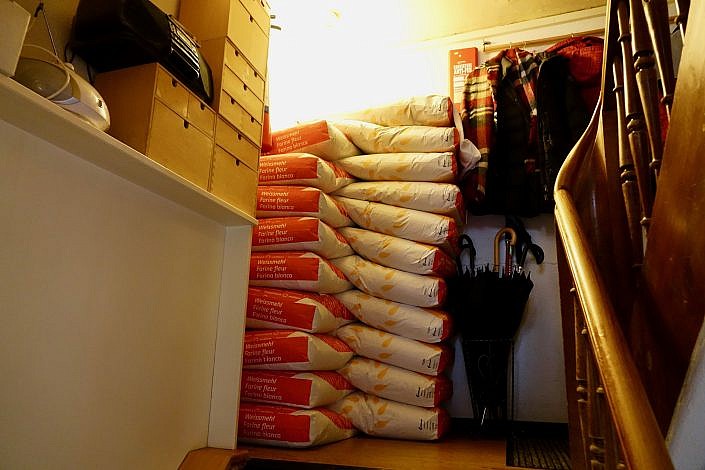Züri Tirggel – a traditional Swiss Christmas cookie
November 16, 2016 — 8 comments
From the 13th century until 1840, only bakers in the city of Zürich had the right to craft this honey sweet. Pressed into molds, then baked in thin flats at high heat, the Tirggel is a delicacy meant to be savoured. A treasure from old when the rhythm of life was slower, the connoisseur of today knows to break off a piece, keep it on the tongue and allow the delicate honey and spice flavor to unfold slowly.
Honey, flour and a secret blend of spices are the main ingredients of Tirggel. Sugar – the high end “fine spice” of Asia and the Middle East – only became a bulk commodity between the 17th and 19th century. Tirggel were a means of communication as much as food. Imprinting the surface with love notes, family-, trade- or business coat-of-arms, biblical scenes and guild trades were favorite subjects. If you had a heavy money purse during the middle ages, you could get your own designs baked. Special city and landscape designs were popular gifts to loved ones in far away lands. To the present day, molds are hand carved in pear wood which is cured no less than 25 years to guarantee that the carved patterns remain stable.
Today, confectioner master Heinrich Honegger is the only remaining baker of traditional, hand-crafted Tirggel in Switzerland. In the quaint town of Wald outside Zürich, in a building that produced Tirggel for more than two hundred years, he crafts the sweet.
As I walk toward the bakery at 8:30 am on a frosty November morning, a strong waft of honey stops me in total surprise ten steps before I reach the bakery. I breathe in deeply. What a delicious smell, and so strong! Esther Honegger opens the door and ushers me through the retail store right into the warm bakery in the back where her husband Heinrich and two helpers are hard at work. Dressed all in white down to the shoes, they are busy rolling, pressing, baking and cutting the first Tirggel batches of the day. Five tons of Tirggel are produced this way every year !
The dough is prepared three days in advance and allowed to rest. I watch as the elastic, smooth clump is rolled out very thinly, then pressed into oiled molds, from which it is immediately and carefully peeled off again, now imprinted with the positive relief of the mold pattern. In trays of two, the Tirggel are closely monitored for up to ninety seconds while baking at 400 degrees Celsius of upper heat only. The sweet emerges golden-brown, its design distinctly raised on the surface, while the bottom remains a delicate white. As the hallmark of a good Tirggel is supposed to be, so when a light is shown against its underbelly, the full splendor of the design on the surface is revealed. Small works of art and every step made by hand!
Esther Honegger laughs when she confirms that not all Tirggel sold in their family bakery are for consumption. “Many people come to buy a favorite subject as a gift, send off to family in another part of the world, or hang it on the wall.” Some things have remained the same throughout the ages. The Honeggers will close the door of their bakery in a few months time when they go into retirement. Not all is lost, however. The secret recipe, exact craft of Honegger Tirggel bakery, and close to 800 molds are passed on to St. Jakob’s in Zurich. This well known foundation runs several successful businesses, employing handicapped people. One of their divisions is a bakery and chocolaterie. Their congenial bakery department manager and master confiseur Urs Jäckle is already training with Tirggel Master Honegger. The tradition continues and the circle is closed with the Tirggel returning to the city of Zürich once again.
While traditionally a Christmas baked item, Tirggel are available year-round in Switzerland. The only hand-crafted ones, however, are from the Honegger bakery and, as of May 2017, from St. Jakob’s bakery in Zürich.
Esther Honegger laughs when she confirms that not all Tirggel she sells in their family bakery are for consumption. “Many people come to buy a favorite subject as a gift, send off to family in another part of the world, or hang on the wall themselves.” It seems, some things have remained the same through the ages! The Honeggers will close the door of their bakery in a few months time when they go into retirement. Not all is lost, however. The secret recipe, exact craft of Honegger Tirggel bakery and hundreds of molds (except their 800 year old heirloom one) are passed on to St. Jakob’s in Zurich. This well known foundation runs several successful businesses, employing handicapped people. One of their divisions is a bakery and chocolaterie. Their congenial bakery department manager and master confiseur, Urs Jäckle, is already training with Tirggel Master Honegger. The tradition continues and the circle is closed with the Tirggel returning to the city of Zurich once again.
While traditionally a Christmas baked item, Tirggel are available year-round in Switzerland. The only hand-crafted ones, however, are from the Honegger bakery or, as of May 2017, from St. Jakob’s bakery in Zürich. Enjoy!
leave a comment below if you’re a fan of Tirggel or have special Christmas cookie memories!
About Silvia and Swiss Wanderlust

Switzerland travel enthusiast. Cat lover, bicyclist and classical music fan. I prefer walking over running and enjoy a good Swiss card game of Jass with friends. More about Silvia and Swiss Wanderlust »
Follow Us on Facebook















Hello Silvia,
Thank you for writing this interesting article. Tirggel I find to be very interesting.
I also appreciate the beautiful photos.
Best regards,
Ken
Dear Ken
There is much history and tradition in so many things little and big in Switzerland I find it fascinating and I’am happy that you enjoyed the information and the photos! There will be more on all sorts of topics, but if there is one that interests you in particular, please let me know. Best wishes,
Silvia
I have become caught up in making springerle cookies and can well appreciate the skills that must be required to make these delicate tirggels. I would love to try one someday. It is good to know the craft is being passed on as the man retires next month. Thanks for the very informative article.
Dear Dan
I too feel that nothing like doing a task myself opens my eyes to what’s really involved! I looked up Springerle cookies. This seems like a very delicate, beautiful and tasty cookie. It looks very similar to what’s called “Chräbeli” in Switzerland; usually also a cookie baked at Christmas time. I hope you will continue to enjoy making them. In the fall, I will follow up on the St. Jacob’s bakery to find out how they are doing with their new traditional Tirggel baking and will post an article at that time. Best wishes,
Silvia
Dear Silvia,
Thank you so much for your sharing those beautiful swiss traditions. I’m so grateful to be able to share them especially the recipes with my kids as we live in the US.
Thank you for your beautiful blog.
Enjoy the holiday season!
Dear Valerie
I’m happy to hear that you and your family are enjoying Swiss Wanderlust! In the latest article titled Swiss Christmas traditions, you and your children might enjoy the suggestions on how to make your own Advent calendar, very much a Swiss tradition. Happy Holiday Season to you all in the US!, Very best, Silvia
Silvia-
I discovered the joy of making springerle cookies this Christmas, when I dusted off some molds which I purchased many years ago in a second hand shop . (I didn’t know what they were at the time.)Since then molded cookies have become an obsession. So far I have some rules for collecting-the molds must be wood, hand-made, useable, etc. Unfortunately, my sweet old molds are developing pressure fractures from use, so I may have to alter my rules a little. Also- I tend to like only molds that I could not possible afford.
Your translucent cookies opened up another rabbit hole to go down. So lovely. I am going to hunt around to see if I can find something of a workable honey wafer recipe. It seems to me that perhaps I could practice molding them on the back of incised glass dishes. We’ll see.
Thank you for opening up this window to the world.
Dear Amy
thank you for your comment and great to hear you’ve re-discovered your Springerle molds! Delicious cookies to eat and so decorative in the bargain. What a great idea to use incised glass ware! And if you create a workable honey wafer recipe, please share it – so many of us are cutting down on refined sugar, always a plus! Have fun experimenting and happy baking, Amy! 🙂
Silvia